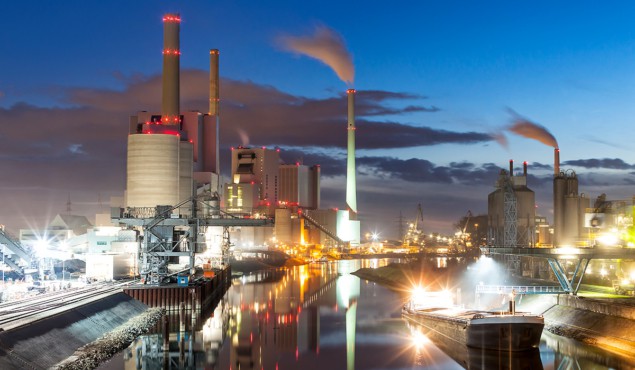Johan Hansson argues that it will never be possible to meet our climate targets if countries continue their obsession with growing the economy

The book Limits to Growth delivered a clear warning for our planet. Published way back in 1972 by Universe Books, it contained 12 scenarios for the world based on simulations carried out two years earlier by a group of scientists at the Massachusetts Institute of Technology (MIT) in the US. Despite selling millions of copies and being translated into 30 languages, the book was heavily criticized by industry leaders and economists for being unrealistic.
Their reaction was surprising given that the “do nothing” MIT simulation scenario – “business as usual” – envisaged global collapse through a depletion of resources, food shortages and industrial decline by 2050. This was a result of increasing ecological pressures that were predicted to begin in the early 2000s. As it turns out, that particular model is currently fitting the world’s current situation frighteningly well.
Many people think that clever advances in technology will save us from the looming catastrophe, where the climate is just the top of the iceberg (albeit deadly in itself). But my concern is that there is a naïve and dangerous overconfidence in technological solutions. Carbon capture and sequestration, for example, currently cannot capture even a fraction of what is needed each year to meet our climate targets.
The dream that “new technology” could save us from peril was another MIT simulation scenario carried out back in the early 1970s. Yet this scenario only extends global collapse by a few years. Merely progressing the “green industry” – the new favourite slogan of business and politicians – is unfortunately not enough.
In my view it is crazy to think that uncontrolled technological “development” and exploitation driven by unbridled, increasingly unequal, capitalism will save us. It is what has plunged us into today’s crisis in the first place. After all, if you are sitting on a tree branch that you are sawing off, and the ground underneath is burning, the solution is not to switch to a better saw – it is to stop sawing.
In any case, why should we rely on economists to put out the fire? I find it tragic that the world is governed exclusively by economists and is driven by economics, which is not a natural science, but just a human invention. There are physical limits to continuous economic expansion – a fact that most economists do not seem to understand. Seen from space, after all, it is obvious that the Earth is a small, isolated and vulnerable spaceship.
Yet some economists mistakenly talk about “decoupling” the economy from the real and strictly limited assets on Earth. Even pure “information” is physical and has limits. Just as the exponential growth of bacteria in a Petri dish dies off when nutrients and space run out, so there are non-negotiable limits to “growth” for humans on Earth.
Long-term view
The MIT scientists did find a simulation that offers a solution. Degrowth, or “stabilized Earth”, is the only route that does not lead to global collapse. The Iroquois people, an ancient Indigenous civilization, knew this. When important decisions had to be made, they thought about how it would affect several generations into the future. Today’s politicians, in contrast, usually have a time perspective of no more than four years (i.e up to the next election) while people in business and industry don’t look further than three months (to the next quarterly report).
Neither is nuclear power the answer. What moral right do we have to convert the small and non-sustainable amount of Earth’s uranium resource into long-lasting hazardous waste for just a few decades of electricity to provide “growth” for our generation? About as much as we had to burn up a large part of the planet’s fossil fuels in just over 100 years, which has now ended up in the atmosphere as carbon dioxide and disrupted the climate.
Nature does not care about our economic considerations and calculations when it decides how to exterminate humanity
Nature does not care about our economic considerations and calculations when it decides how to exterminate humanity. Economic growth was meant to help people, lifting them out of poverty. But today, humanity has instead become a slave to sacred growth figures – which has become a monster completely out of control. The economist Simon Kuznets, who coined the concept of gross domestic product in 1934, even warned against using such a crudely simplified concept as some kind of naïve numerical measure of welfare in an extremely complex world.

Climate change expected to reduce the quality of ground-based astronomical observations
Role models like climate activist Greta Thunberg are trying to save those who, for some reason, have not yet understood how serious the situation actually is. To reach the climate pledge of limiting global warming below 1.5 °C, the use of fossil fuels must completely cease by 2035, with zero deforestation and a drastic reduction in other greenhouse gas emissions. Yet according to the International Energy Agency, about 80% of the world’s energy today still comes from fossil fuels.
One international organization that draws attention to the world’s environmental problems is the Global Footprint Network, which each year marks Earth Overshoot Day. This is the date on which humanity’s demand for ecological resources and services in that particular year exceeds what Earth can regenerate. In 2023 it fell on 2 August, meaning that for the rest of the year we effectively “stole” from future generations.
There is one option to reverse the current trend and that is to abide by Earth’s natural limits. Governments need to realize that rich countries must adapt their production and consumption to bring it below what is sustainable for the Earth-system as a whole. The only alternative to a planned and controlled downsizing is a forced and catastrophic global collapse.
Only degrowth can save us.
- SEO Powered Content & PR Distribution. Get Amplified Today.
- PlatoData.Network Vertical Generative Ai. Empower Yourself. Access Here.
- PlatoAiStream. Web3 Intelligence. Knowledge Amplified. Access Here.
- PlatoESG. Carbon, CleanTech, Energy, Environment, Solar, Waste Management. Access Here.
- PlatoHealth. Biotech and Clinical Trials Intelligence. Access Here.
- Source: https://physicsworld.com/a/the-climate-is-doomed-if-we-continue-to-be-fixated-by-economic-growth/
- :has
- :is
- :not
- :where
- $UP
- 1
- 100
- 12
- 160
- 1934
- 2%
- 2000s
- 2023
- 2035
- 2050
- 30
- 5
- 90
- a
- About
- According
- Activist
- actually
- adapt
- advances
- affect
- After
- against
- agency
- albeit
- All
- alternative
- amount
- an
- Ancient
- and
- Another
- answer
- any
- ARE
- Argues
- AS
- Assets
- At
- Atmosphere
- attention
- AUGUST
- back
- Bacteria
- based
- BE
- become
- begin
- being
- below
- Better
- book
- Books
- Branch
- bring
- burn
- burning
- business
- but
- by
- calculations
- CAN
- cannot
- capitalism
- capture
- carbon
- carbon capture
- carbon dioxide
- care
- carried
- case
- catastrophic
- cease
- change
- clear
- clever
- Climate
- coined
- Collapse
- comes
- completely
- complex
- concept
- Concern
- considerations
- consumption
- contained
- continue
- continuous
- contrast
- control
- controlled
- convert
- copies
- could
- countries
- courtesy
- crazy
- crisis
- criticized
- Current
- Currently
- Dangerous
- Date
- day
- decades
- decisions
- Decline
- deforestation
- delivered
- Demand
- Despite
- despite selling
- DID
- dish
- disrupted
- do
- does
- Domestic
- Dont
- Doomed
- downsizing
- draws
- dream
- driven
- e
- each
- Earlier
- Early
- earth
- Ecological
- Economic
- Economic growth
- Economics
- Economist
- economists
- economy
- effectively
- Election
- electricity
- Emissions
- ended
- energy
- enough
- environmental
- estimates
- Even
- example
- exceeds
- exclusively
- expected
- exploitation
- exponential
- Exponential Growth
- extends
- extremely
- fact
- few
- Figures
- Find
- Fire
- First
- fitting
- food
- Footprint
- For
- forced
- fossil
- fossil fuels
- four
- fraction
- from
- fuels
- further
- future
- GAS
- generation
- generations
- giant
- given
- Global
- global warming
- governed
- Governments
- greenhouse gas
- Greenhouse gas emissions
- gross
- Ground
- Group
- Growing
- Growth
- had
- Have
- heavily
- help
- How
- How To
- http
- HTTPS
- human
- Humanity
- Humans
- i
- IEA
- if
- important
- in
- In other
- increasing
- increasingly
- industrial
- industry
- information
- instead
- Institute
- International
- into
- Invention
- isolated
- issue
- IT
- itself
- jpg
- just
- Kind
- knew
- Languages
- large
- lead
- leaders
- lifting
- like
- LIMIT
- Limited
- limiting
- limits
- Look
- looming
- made
- massachusetts
- Massachusetts Institute of technology
- max-width
- meaning
- meant
- measure
- Meet
- merely
- millions
- MIT
- model
- models
- months
- moral
- more
- most
- much
- must
- my
- Natural
- Nature
- Need
- needed
- never
- New
- next
- no
- now
- nuclear
- Nuclear power
- numerical
- obvious
- of
- off
- Offers
- on
- ONE
- only
- Option
- or
- organization
- Other
- our
- out
- over
- overconfidence
- part
- particular
- People
- perspective
- Petri
- physical
- Physics
- Physics World
- Place
- planet
- planned
- plato
- Plato Data Intelligence
- PlatoData
- Pledge
- plunged
- Politicians
- possible
- Poverty
- power
- predicted
- pressures
- problems
- Product
- Production
- progressing
- provide
- published
- pure
- put
- quality
- reach
- reaction
- real
- realize
- reason
- reduce
- reduction
- rely
- report
- resource
- Resources
- REST
- result
- reverse
- Rich
- right
- Route
- Run
- s
- sacred
- Save
- saw
- scenario
- scenarios
- Science
- scientists
- seem
- seen
- Selling
- sequestration
- serious
- Services
- several
- shortages
- should
- simplified
- simulation
- simulations
- Sitting
- situation
- small
- So
- solution
- Solutions
- some
- Space
- station
- Still
- Stop
- strictly
- such
- surprising
- sustainable
- Switch
- Talk
- targets
- technological
- Technology
- telescope
- than
- that
- The
- The Economist
- The Future
- the world
- their
- Them
- There.
- they
- Think
- this
- those
- thought
- three
- Through
- thumbnail
- time
- to
- today
- today’s
- top
- translated
- tree
- Trend
- true
- trying
- turns
- two
- underneath
- understand
- understood
- unfortunately
- Universe
- us
- use
- using
- usually
- View
- Vulnerable
- warned
- warning
- was
- Waste
- Way..
- we
- Welfare
- were
- What
- What is
- when
- which
- while
- WHO
- whole
- why
- will
- with
- world
- world’s
- would
- year
- years
- yet
- you
- zephyrnet
- zero












